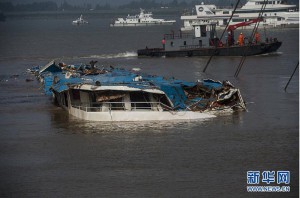YIBIN, Sichuan, March 30 (Greenpost) — A ship loaded with three tanks weighing about 60 tonnes each is nearing Shanghai during a pioneering two-week journey starting from southwest China’s Yibin City along the Yangtze River.
Such a shipment from China’s inland along the mighty Yangtze would have been impossible just a few years ago when only small docks for barges, ferries and fishing boats dotted Yibin’s banks.
Yibin, an industrial city known for coal mining and liquors, used to rely on trucks and trains to transport goods, even though it is where two upper tributaries meet to form the main section of the Yangtze.
Local authorities began developing a major port in Yibin in 2010, amid broader work by China to turn the Yangtze into a “golden waterway” with an enhanced role as the cargo artery between the wealthy coast and the vast under-developed inland. Central and local governments see increasing trade as the key to strengthening economies away from the coast.
On March 25, the Communist Party of China Central Committee passed a guideline on developing the Yangtze River Economic Belt, stressing that the program must be driven by market principles and have green credentials.
Yibin was years ahead of the curve. Its port with five docks is designed to handle half a million containers and 2.24 million tonnes of cargo every year. Ships of up to 3,000 tonnes can set sail even in the dry season.
Transporting giant goods like the tanks by land is extremely difficult, as they would overload lorries or trains and have to be dismantled to pass through tunnels or bridges. The costs tend to be very high, explained Yuan Daiqian, general manager of Jiangyuan Chemical Engineering Machinery, which manufactured the tanks for a fertilizer plant being built by Japanese conglomerate Mitsubishi in Turkmenistan.
Thanks to the Yibin Port and new shipping routes, “we can do business that was not possible before,” Yuan said. His company has manufactured 71 pieces of large equipment for Mitsubishi’s project, including the tanks.
They will head for Turkmenistan from Shanghai, where the Yangtze empties into the sea. Shanghai International Port Group and the government of Yibin co-funded the construction of Yibin Port.
Yibin’s shipping industry has grown rapidly as investment has flowed to infrastructure along the Yangtze River.
The volume of goods passing through Yibin harbor has been growing at an average 130 percent a year since the port became operational in 2010. It handled 200,000 containers in 2015 and 66,000 in the first quarter of 2016.
China’s development of the Yangtze River Economic Belt has accelerated since a plan approved by the government in September 2014.
There is certainly a lot riding on it. The belt includes nine provinces and two municipalities. It spans 2.05 million square km and accounts for more than 40 percent of China’s population and economic aggregate.
Yibin, a city of about five million people, is nudging into the global market through better connection with big cities along the river.
It has launched shipping routes to Japan and the Republic of Korea via central China’s Wuhan and east China’s Nanjing and Shanghai. It is also planning four routes to Southeast Asia.
As a result, Yibin’s foreign trade reached 890 million U.S. dollars and 950 million U.S. dollars in 2014 and 2015, growing at 9.1 percent and 7 percent year on year, at a time when China’s overall foreign trade has stalled.
To help e-commerce, Yibin is also building a bonded warehouse where imported goods can be stored without paying duty. With a storage area of 53,000 square meters, the warehouse is due to open before the end of June.
“The golden waterway has boosted Yibin’s shipping cooperation with cities along the Yangtze, opening up markets for local companies and improving their competitiveness by saving transport costs,” said Liu Zhengyu, board chairman of Yibin Port.
“When e-commerce gets going, this industrial city will become a major trading center in southwest China,” Liu said. Enditem
Source Xinhua
